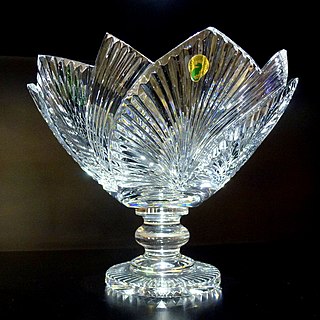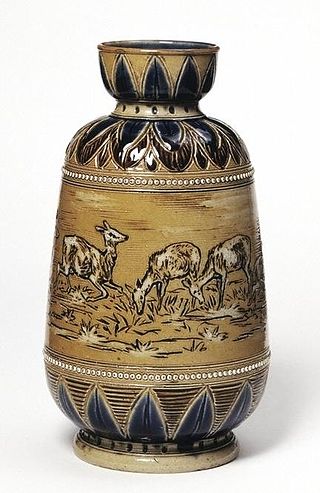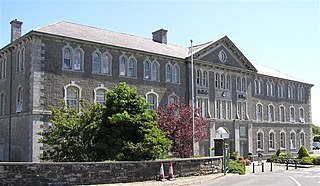
Stoneware is a broad term for pottery fired at a relatively high temperature. A modern definition is a vitreous or semi-vitreous ceramic made primarily from stoneware clay or non-refractory fire clay. End applications include tableware, decorative ware such as vases.

Waterford Crystal is a manufacturer of lead glass or "crystal", especially in cut glass, named after the city of Waterford, Ireland. In January 2009, the main Waterford Crystal manufacturing base on the edge of Waterford was closed due to the insolvency of Waterford Wedgwood PLC, and in June 2010, Waterford Crystal relocated almost back to the roots of glass-making in the city centre. The Mall location holds both a manufacturing facility that melts over 750 tonnes of crystal a year - although most Waterford Crystal is now produced outside Ireland - and a visitor centre with the world's largest collection of Waterford Crystal. As of 2015, the brand is owned by the Fiskars Corporation.

The Staffordshire Potteries is the industrial area encompassing the six towns Burslem, Fenton, Hanley, Longton, Stoke and Tunstall, which is now the city of Stoke-on-Trent in Staffordshire, England. North Staffordshire became a centre of ceramic production in the early 17th century, due to the local availability of clay, salt, lead and coal.
Fiskars Group is a Finnish group company. The company has its roots in the village of Fiskars, where it was founded in 1649. The oldest business still operating in Finland, its global headquarters are in Keilaniemi, Espoo, Finland. It is one of the oldest companies in the world.
Waterford Wedgwood plc was an Irish holding company for a group of firms that specialized in the manufacture of high-quality porcelain, bone china and glass products, mostly for use as tableware or home decor. The group was dominated by Irish businessman Tony O'Reilly and his family, including his wife Chryss Goulandris and her family, with the two families together having invested hundreds of millions of euros in it. The group's financial record was mixed, and significant cost-cutting had been ongoing for many years.

The Midwinter Pottery was founded as W.R. Midwinter by William Robinson Midwinter in Burslem, Stoke-on-Trent in 1910 and had become one of England's largest potteries by the late 1930s with more than 700 employees. Production of Midwinter pottery ceased in 1987.

Wedgwood is an English fine china, porcelain and luxury accessories manufacturer that was founded on 1 May 1759 by the potter and entrepreneur Josiah Wedgwood and was first incorporated in 1895 as Josiah Wedgwood and Sons Ltd. It was rapidly successful and was soon one of the largest manufacturers of Staffordshire pottery, "a firm that has done more to spread the knowledge and enhance the reputation of British ceramic art than any other manufacturer", exporting across Europe as far as Russia, and to the Americas. It was especially successful at producing fine earthenware and stoneware that were accepted as equivalent in quality to porcelain but were considerably cheaper.

Royal Doulton is an English ceramic and home accessories manufacturer that was founded in 1815. Operating originally in Vauxhall, London, and later moving to Lambeth, in 1882 it opened a factory in Burslem, Stoke-on-Trent, in the centre of English pottery. From the start, the backbone of the business was a wide range of utilitarian wares, mostly stonewares, including storage jars, tankards and the like, and later extending to drain pipes, lavatories, water filters, electrical porcelain and other technical ceramics. From 1853 to 1901, its wares were marked Doulton & Co., then from 1901, when a royal warrant was given, Royal Doulton.

Mintons was a major company in Staffordshire pottery, "Europe's leading ceramic factory during the Victorian era", an independent business from 1793 to 1968. It was a leader in ceramic design, working in a number of different ceramic bodies, decorative techniques, and "a glorious pot-pourri of styles - Rococo shapes with Oriental motifs, Classical shapes with Medieval designs and Art Nouveau borders were among the many wonderful concoctions". As well as pottery vessels and sculptures, the firm was a leading manufacturer of tiles and other architectural ceramics, producing work for both the Houses of Parliament and United States Capitol.

Belleek Pottery Ltd is a porcelain company that began trading in 1884 as the Belleek Pottery Works Company Ltd in Belleek, County Fermanagh, Ireland in what was to later become Northern Ireland. The factory produces Parian ware that is characterised by its thinness, slightly iridescent surface and body formulated with a significant proportion of frit.

J. & G. Meakin was an English pottery manufacturing company founded in 1851 and based in Hanley, Stoke-on-Trent, Staffordshire.

Art pottery is a term for pottery with artistic aspirations, made in relatively small quantities, mostly between about 1870 and 1930. Typically, sets of the usual tableware items are excluded from the term; instead the objects produced are mostly decorative vessels such as vases, jugs, bowls and the like which are sold singly. The term originated in the later 19th century, and is usually used only for pottery produced from that period onwards. It tends to be used for ceramics produced in factory conditions, but in relatively small quantities, using skilled workers, with at the least close supervision by a designer or some sort of artistic director. Studio pottery is a step up, supposed to be produced in even smaller quantities, with the hands-on participation of an artist-potter, who often performs all or most of the production stages. But the use of both terms can be elastic. Ceramic art is often a much wider term, covering all pottery that comes within the scope of art history, but "ceramic artist" is often used for hands-on artist potters in studio pottery.
John Beswick Ltd, formerly J. W. Beswick, was a pottery manufacturer, founded in 1894 by James Wright Beswick and his sons John and Gilbert in Longton, Stoke-on-Trent. In 1969, the business was sold to Doulton & Co. Ltd. The factory closed in 2002 and the brand John Beswick was sold in 2004. The pottery was chiefly known for producing high-quality porcelain figurines such as farm animals and Beatrix Potter characters and have become highly sought in the collectables market. Pronunciation of Beswick is as at reads, Bes-wick. This information was from employees who worked at the original Beswick factory.

Dudson is a British company that manufactured tableware, glassware and porcelain, in Hanley, Stoke-on-Trent. It is one of the oldest brands of its industry in England, founded in 1800.

Franciscan Ceramics are ceramic tableware and tile products produced by Gladding, McBean & Co. in Los Angeles, California, US from 1934 to 1962, International Pipe and Ceramics (Interpace) from 1962 to 1979, and Wedgwood from 1979 to 1983. Wedgwood closed the Los Angeles plant, and moved the production of dinnerware to England in 1983. Waterford Glass Group plc purchased Wedgwood in 1986, becoming Waterford Wedgwood. KPS Capital Partners acquired all of the holdings of Waterford Wedgwood in 2009. The Franciscan brand became part of a group of companies known as WWRD, an acronym for "Wedgwood Waterford Royal Doulton." WWRD continues to produce the Franciscan patterns Desert Rose and Apple.

Ironstone china, ironstone ware or most commonly just ironstone, is a type of vitreous pottery first made in the United Kingdom in the early 19th century. It is often classed as earthenware although in appearance and properties it is similar to fine stoneware. It was developed in the 19th century by potters in Staffordshire, England, as a cheaper, mass-produced alternative for porcelain.

The Ridgway family was one of the important dynasties manufacturing Staffordshire pottery, with a large number of family members and business names, over a period from the 1790s to the late 20th century. In their heyday in the mid-19th century there were several different potteries run by different branches of the family. Most of their wares were earthenware, but often of very high quality, but stoneware and bone china were also made. Many earlier pieces were unmarked and identifying them is difficult or impossible. Typically for Staffordshire, the various businesses, initially set up as partnerships, changed their official names rather frequently, and often used different trading names, so there are a variety of names that can be found.

Enoch Wood (1759–1840) was an English potter and businessman, from one of the major families in Staffordshire pottery. Starting as a modeller, he established a successful business in Burslem in the Staffordshire Potteries, from 1790-1818 trading as Wood and Caldwell. In the 18th century they produced many Staffordshire figures, which Wood modelled himself, and other types of earthenware and stoneware. After 1818 his company, now Enoch Wood & Sons, produced large quantities of blue and white transfer-printed tableware in earthenware, much of which was exported to America.

Millicent (Millie) Jane Taplin (1902–1980) was a British designer and painter of ceramics who spent most of her career at Josiah Wedgwood and Sons (1917–1962). She was trained in painting by Alfred and Louise Powell, and supervised Wedgwood's ceramics painters. She became a designer of decorative patterns in 1929 and by the mid-to-late 1930s was one of the company's main designers, although she did not design pottery shapes. She was one of only two working-class women to become a successful ceramics designer before the Second World War. Her tableware designs were exhibited by Wedgwood at Grafton Galleries in London in 1936, and several of her designs are now on display at the V&A Museum. Her design "Strawberry Hill", with Victor Skellern, was awarded the Council of Industrial Design's Design of the Year Award in 1957.

Alfred Meakin Ltd Pottery was a British company that produced earthenware and semi-porcelain tableware, tea sets, and toilet ware from 1875 to 1976. The company was founded by Alfred Meakin, the brother of James and George Meakin who ran a large pottery company in Hanley, Stoke-on-Trent. Alfred Meakin operated from the Royal Albert, Victoria, and Highgate Potteries in Tunstall and later acquired the Newfield Pottery and the Furlong Mill. The company was known for its ironstone china and white granite ware, which were exported to many countries, especially the USA. The company also made decorative wares with various patterns and shapes, such as Bamboo, Fishhook, Chelsea, and Bleu de Roi. The company was bought by Robert Johnson, Alfred's uncle, for his son Stuart Johnson in 1908, and remained in the Johnson family until 1976, when it became part of Myott-Meakin and later Churchill Group A tile from 1901 is held by the British Museum and a dinner service is held by Canterbury Museum and work is in the National Trust Art collection. Work is held by the Science Museum Group and the V&A.






















